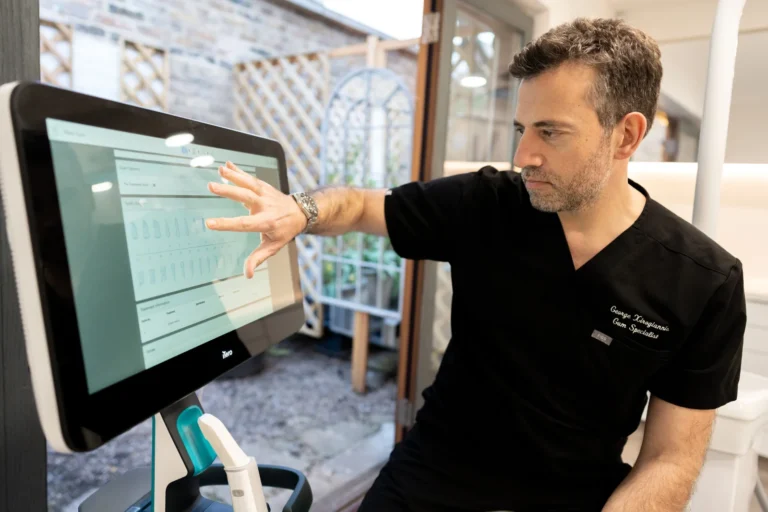Smiles, as we know, are considered vital facial expressions. A beautiful smile is an essential indication of a healthy, attractive, and confident person. It’s not just a result of the mouth’s cleanliness, but also the stability and appearance of the teeth themselves.
Similarly, cosmetic dentistry is not just about whitening and straightening teeth. In some cases under that beautiful smile there could have been processes like root canal therapy saving teeth when they might otherwise be extracted. Below we’ll discuss the association between endodontic treatments and cosmetic dentistry and how preserving a natural tooth improves the aesthetics of your smile.
Table of Contents
ToggleNatural Teeth in Cosmetic Dentistry
Arguably the most important and widely practiced principle of cosmetic dentistry is Prince’s maxim, ‘first, do no harm.’ Even with dental implants, bridges, and dentures, solutions are there for replacements for lost teeth, but none of these can truly recreate exactly the aesthetic, structural, or biomechanical factors of natural teeth. It is very important to note that your natural teeth, the ones God-equipped you with to work with your mouth’s natural and unique structure, bite and alignment, are designed to complete the natural beauty of your face.
Most patients who develop a complication related to a tooth may naturally feel that extraction is the only solution, particularly when the big question that most patients ask is: ‘What should I do with this ugly, decayed, or discolored tooth?’ However, root canal treatment is a way to save a tooth – the dentist removes the infected pulp and fills the resulting space, leaving your beautiful smile intact. This is where endodontics (a specialty of dental medicine that deals with root canal therapy) and aesthetic, cosmetic dentistry meet.
Cosmetic dentistry is not only a way of enhancing the looks of your teeth. It also affirms the need to retain the hard tissues, physical functions and your general oral health. Root canals are central to this process as it treats the tooth from the inside, while cosmetic dentistry focuses on the outer structure without affecting the tooth’s health.
How Root Canals Help Preserve Your Teeth and Your Smile
A root canal treatment is done when a tooth’s pulp is infected or damaged in some way. This may be an outcome of severe caries, injury to the tooth, or a break in the enamel capable of allowing bacteria to reach the pulp. The pulp, nerves, and blood vessels are only required when a tooth is being formed, and as soon as a tooth is formed, it can work independently even if the pulp is no longer there. However, when an infection occurs, besides the pain and discomfort experienced, the tooth is likely to be lost, especially if the condition is not treated early enough.
In a nutshell, a root canal treatment is a process through which the affected or damaged pulp in the tooth is removed, and the interior is thoroughly washed, disinfected and later filled to avoid further infection. Thereby, the natural tooth is saved. The outer shell of the tooth remains solid, and for the function of the tooth together with aesthetics, the tooth can be ‘reconditioned’ with a crown or cosmetic work. This is important in retaining the smile’s normal appearance.
Concentration of infection within the gum line, and the lack of a natural tooth, can complicate several factors that affect your overall oral health and appearance. Spaces that exist when there is a missing tooth can cause teeth to shift position to fill the gap, leading to misalignment and a change in bite. In addition, the loss of a tooth leads to resorption, a process whereby the jawbone reduces in size.
The Cosmetic Impact of a Root Canal Treatment
In addition to its remedial purpose to address an infection or pain in a tooth, root canal treatment has a strong aesthetic component. Dental pulp that is damaged or inflamed will eventually appear discolored or be situated in a tooth with a crack or cavity. Once the infection is eliminated, the dentist can replace the lost material and put it back in its natural colour so as not to stand out from the rest of the teeth in your mouth.
Sometimes, a crown may be recommended for the tooth after a root canal because it will be weaker than before. Dental crowns are made from materials that reflect the color, size, and shape of your natural teeth, thus making them functional as well as aesthetic. Porcelain and actual composites of resins currently used in dental treatment enable experts to construct crowns that resemble natural teeth. This cosmetic feature will make the tooth look healthy and natural, at the same time providing strength to withstand any further decay.
Chromosomal changes can also manifest in a tooth that had been rooted but later subjected to a root canal treatment. When this happens, solutions in cosmetic dentistry, such as tooth whitening or application of veneers, are further provided to enhance the tooth’s appearance. Procedures such as veneers involve making delicate and personalized shells that are fixed to the front of the tooth to correct the shape and color of the tooth, and that too within a short period. All these treatments can only be done where there is no infection on the tooth; therefore, a root canal treatment can be the first step in the beauty enhancement of teeth.
The Role of Root Canals in Preventing Future Cosmetic Issues
A root canal does not just help preserve a tooth’s shape in the short run, as many people think. It also has the secondary use of working as insurance against permanent stains on your smile’s teeth. In addition to saving a natural tooth without infection, root canals can avoid more serious oral health conditions that may call for extreme cosmetic dental procedures.
People seek dental implants, bridges, and dentures if the tooth is irreversibly infected and needs to be removed. Although these options work well, they may require further adjustments to give the patient a fuller, more natural-looking smile. Dental implants, therefore, are a process that may take several visits to the dentist – over several months. They entail the insertion of a metal post made of titanium in the jawbone and then attachment to a porcelain crown. What you get from this procedure is a long-lasting and beautifully replicated tooth that looks identical to the adjacent teeth; however, this procedure is much more invasive and expensive than just keeping the natural tooth alive with a root canal treatment.





